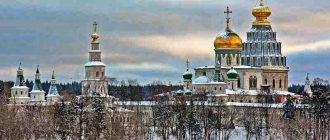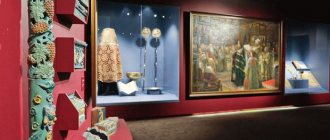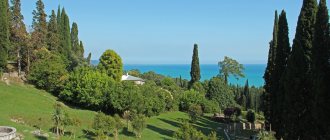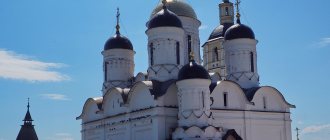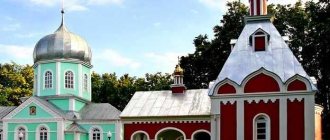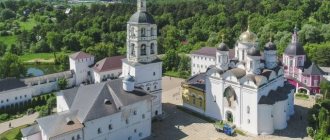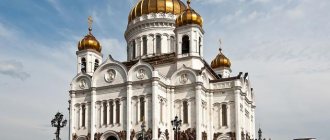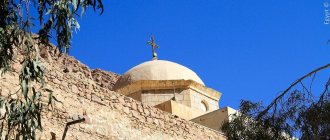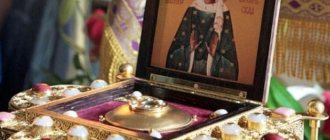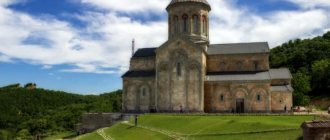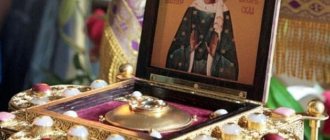| New Jerusalem Monastery, September 2007. Photo from sobory.ru |
New Jerusalem Monastery in honor of the Resurrection of Christ
, stauropegy of the Russian Orthodox Church within the boundaries of the Odintsovo diocese
- Address: Russia, 143500, Moscow region, Istra, st. Sovetskaya, 2
- Tel/fax: 994-61-70
- Official site:
- On the map: Yandex.Map, Google map
The history of the Resurrection New Jerusalem Monastery is closely connected with the memory of its founder, Patriarch Nikon.
This monastery was the favorite of the three monasteries he founded: Iversky, Krestnoy and Resurrection. Here he lived for more than eight years after his departure from Moscow and used all his strength to implement his plan - to create in the Moscow region an exact likeness of the famous Jerusalem Church of the Resurrection of the Lord in order to enable the Russian people to contemplate the places of the saving passion and Resurrection of Christ without undergoing an expensive and unsafe journey to the Middle East. The construction, begun by the Patriarch in 1656, during his friendship with Tsar Alexei Mikhailovich, and continued with his assistance even during the period of cooling of this friendship from 1658 to 1666, was suspended for almost 14 years with the exile of the Patriarch at the end of 1666, but resumed through the diligence of Tsar Fyodor Alekseevich and thanks to the efforts of his aunt Princess Tatyana Mikhailovna in 1679. During his reign, the Patriarch’s desire to return, alive or dead, to his beloved monastery was fulfilled; he received permission to return to New Jerusalem, but died on the way from exile and was buried in the chapel of the Beheading of John the Baptist of the Resurrection Cathedral on August 26, 1681. Unfortunately, in the 30s, the Soviet authorities opened the coffin of Patriarch Nikon and the location of his remains is still unknown.
After the death of Tsar Fyodor Alekseevich, during which time the entire building of the Resurrection Cathedral was brought to the vaults, construction continued under Tsars John and Peter Alekseevich and on January 18, 1685, the cathedral was consecrated by Patriarch Joachim. In 1686, the sovereign ktitors of the Resurrection Cathedral granted the Resurrection Monastery a grant, the so-called “eternally approved charter” for all its then estates and lands.
| New Jerusalem Monastery |
The heirs of the kings who built the Cathedral of the Resurrection of Christ continued to be especially merciful towards the New Jerusalem monastery.
During the reign of Empress Elizabeth Petrovna, after the fall in 1723 of the hipped roof of the rotunda, under which the Chapel of the Holy Sepulcher was located, and the fire of 1726, the cathedral, which was approaching final destruction in 1749-1759, was restored by her will and decorated inside with stucco according to the design and drawings the architect Count Rastrelli, under the direct supervision of the rector of the monastery, Archimandrite Ambrose (Zertis-Kamensky). Empress Catherine II continued the improvement of the Resurrection Monastery and also donated funds for the restoration of monastery buildings after the fires of 1762 and 1792. Subsequent Sovereigns set up altars in the Resurrection Cathedral in memory of the birth of the heir; Emperors Paul and Nicholas built two chapels in the name of the holy blessed Alexander Nevsky and a chapel in the name of the Nativity of the Blessed Virgin Mary in memory of the birth on this day of Tsarevich Nikolai Alexandrovich.
In the 19th and early centuries, the monastery was one of the most popular centers of pilgrimage; the number of its visitors especially increased after the Nikolaev and then Riga railways were built nearby. In 1913, the monastery was visited by about 35,000 people; a hospice house for poor pilgrims and hotels were built at the monastery’s expense. The constant attention of the imperial family to the monastery at this time is evidenced by the rich contributions to the sacristy.
The beginning of scientific study of the history of New Jerusalem dates back to the 19th century; the largest historian of the monastery was Archimandrite Leonid (Kavelin), a researcher of monuments of the Christian East, manuscripts of the New Jerusalem, Kaluga antiquities and inscriptions of the Trinity-Sergius Lavra. His fundamental work “Historical Description of the Resurrection, New Jerusalem Monastery,” published in 1874, contains not only a historical outline, but also the publication of many now lost valuable documents of the 17th century. Archimandrite Leonid founded the monastery museum, in which the personal belongings of Patriarch Nikon, paintings, icons, books, and fabrics from the monastery collection were exhibited.
In 1875, Archimandrite Amphilochius (Sergievsky-Kazantsev) published “Description of the Library of the Resurrection Monastery,” which describes 242 manuscripts of the 11th-18th centuries and 135 printed books of the 16th-17th centuries. The library of the Resurrection Monastery contained the Resurrection and Nikon Chronicles, and the “Svyatoslav Collection of 1073” - the second oldest dated Russian manuscript. In 1907, handwritten books from the monastery library were transferred to the Synodal Library, where they compiled a special Resurrection Collection; in 1920, the Resurrection Collection was transferred to the Historical Museum, where it is kept to this day.
In July 1919, by decision of the Zvenigorod district congress of councils, the Resurrection Monastery was closed and its property was nationalized. The collections of the existing Historical, Architectural and Art Museum “New Jerusalem” contain a museum plaque with the following text: “The Great Russian Revolution handed over the New Jerusalem Monastery and Cathedral to the people. From now on, having ceased to serve religious affairs, it is an artistic and historical monument of antiquity of All-Russian significance.” In the 20s of the century, the most valuable items from the sacristy of the Resurrection Cathedral were transferred to the Armory.
In December 1941, New Jerusalem found itself in the zone of fierce battles for Moscow, the monastery buildings were badly damaged, some were completely destroyed, information about the destruction in New Jerusalem appeared in the Nuremberg trials. Starting from the 50s, active restoration work was carried out in the monastery, as a result of which the architectural complex of the monastery was raised from the ruins, and work began on the restoration of the interior decoration of the Resurrection Cathedral.
On July 18, 1994, the Holy Synod of the Russian Orthodox Church heard a message from Patriarch Alexy II of Moscow and All Rus' about the resumption of the activities of the Resurrection New Jerusalem Monastery and the appointment of a vicar of the monastery. The following decision was made: “With gratitude to the Lord, accept the news of the revival of the New Jerusalem monastery under the canonical control of the Patriarch of Moscow and All Russia. To approve Archimandrite Nikita (Latushko) as abbot of the Stavropegial Resurrection New Jerusalem Monastery.”
On July 23, 2008, Patriarch Alexy II and Russian President D.A. visited New Jerusalem. Medvedev. They examined the buildings of the monastery, and, convinced of how much still needed to be done to restore the former splendor of the monastery, they decided to create a Charitable Foundation for the restoration of the Resurrection New Jerusalem Monastery and agreed to become co-chairs of its Board of Trustees.
Monastery concept
The river, called Istra on maps, is here renamed Jordan, where Christ was baptized. In the Resurrection Cathedral everything is told about the Way of the Cross of Christ. Inside the temple there is a cuvuklia, a chapel in which the Holy Sepulcher is located. At the entrance there is a stone similar to the one from which the Angel pointed to the burial place of Christ.
At the beginning of the Sorrowful Path there is a temple-dungeon , where the Savior spent the night in chains before his execution. At the top is Golgotha, the mountain on which criminals were put to shameful execution. The cross was brought for her by order from Jerusalem.
Opposite the entrance to the temple is the stone of anointing . Here lay Jesus, taken down from the cross. To the right of the entrance, Patriarch Nikon is buried, according to the plan and under whose leadership the New Jerusalem Resurrection Stavropegic Monastery was built in the 17th century, the features of which will be discussed.
Wooden predecessor of the stone cathedral
As happened in the history of most monasteries, the construction of the Resurrection New Jerusalem Monastery began with the appearance of wooden buildings made in the traditional style of Russian architecture. With the participation of Patriarch Nikon, a whole complex of such structures was created, the center of which was the Church of the Resurrection.
Its consecration, which took place in October 1657, was attended by Tsar Alexei Mikhailovich, who for the first time named the monastery, which was being built 60 miles from Moscow, New Jerusalem. With his light hand, this phrase took root and, having received official status, has been preserved to this day. Being under the patronage of the sovereign, the new monastery in a short time became a major landowner. In various districts of Russia, even those located at a considerable distance, estates were acquired for him along with the serfs assigned to them.
New Jerusalem Temple - a living icon
The site for the construction of the monastery was chosen by the Patriarch of All Rus' Nikon, who planned to build a “copy of the Holy Land” near Moscow - an icon on the ground with a deep symbolic meaning. According to Nikon's plan, the monastery should become the center of the Orthodox world for the Slavic peoples.
About the foundation of the temple
The young Tsar Alexei Mikhailovich, the future father of Peter I, had unlimited trust in the patriarch and supported the grandiose plan. The patriarch founded his favorite creation in the Moscow region in 1656 - the residence of the Patriarchs should be located not far from the royal capital, but a little to the side. This symbolized the relationship between secular and ecclesiastical authorities.
Having never been to Jerusalem himself, Patriarch Nikon used all his strength to bring his plan to life - to create an exact likeness of the Jerusalem Church of the Resurrection of the Lord, so that the Russian people could contemplate the places of the passion and Resurrection of Christ. He cared for those who could not visit the Holy Land. A model of the Church of the Holy Sepulcher, made of ivory, was sent to Nikon as a gift by the Patriarch of Jerusalem Paisius.
Features of creating a monastery
Erecting a monastery in a bend of the Istra River on a high hill, Patriarch Nikon began to recreate a kind of temple city with an exact copy of the outskirts of Jerusalem, a semblance of the holy places of Palestine. The geographical names were changed: the hills surrounding the monastery were called Eleonsky and Tavorsky, the villages - Preobrazhenskoye, Nazareth, Capernaum.
The fast, winding Istra River was named Jordan. The stream flowing around the monastery hill is the Kidron Stream. The city of Istra was called Voskresensk until 1930. The surroundings of the future monastery were also redesigned: the forest on the banks of the Istra River was cut down to achieve similarity with the landscape in the Holy Land, the hill on which the monastery was built was strengthened and filled.
Personality of Patriarch Nikon
Using the tsar’s trust, Patriarch Nikon actually ruled the country. The energetic and powerful patriarch carried out church reforms according to the European model. Meeting the discontent of the boyars, he opposed him decisively, even harshly. Opponents of the reforms were persecuted and executed. Nikon's actions led to a terrible church schism.
In 1658, the patriarch lost the trust of the king and retired to a monastery, where he personally supervised the construction of the New Jerusalem, as he called his brainchild. The Patriarch wanted to unite people here so that they would pray together, appreciate life and each other.
In 1666, Nikon was defrocked and sent to the remote Ferapontov Monastery as a simple monk, blaming the renaming of the area in Jerusalem. The monastery under construction, whose construction was interrupted for 14 years due to Nikon’s disgrace, began to be called simply Resurrection.
Architectural and landscape ensemble of the monastery
In the center of the lands intended for the monastery, in front of the eyes of amazed contemporaries, under the leadership of Patriarch Nikon, the New Jerusalem began to emerge.
What's on site
Mount Golgotha, the Cave of the Holy Sepulcher, the site of the three-day burial and Resurrection of the Savior are reproduced here. The territory of the monastery was built up with wooden structures. Tsar Alexei Mikhailovich granted the monastery new estates in different districts, so that the monastery became the largest landowner.
In the center of the monastery territory on a hill called Zion , a main cathedral was erected in the likeness of the Church of the Holy Sepulcher in Jerusalem. To replicate its architecture, the cathedral was made up of four parts: a central cross-domed church, a rotunda around the Holy Sepulcher, an underground church of Constantine and Helen, and a bell tower.
The Resurrection Cathedral, being a copy of the Church of the Holy Sepulcher, lacks the severity of the prototype. His appearance reflected the aspirations of the Russian people about the heavenly beauty of the Heavenly World, about the bright eternal life.
Architectural structure of the Resurrection Cathedral
The cathedral resembles a Russian tower, decorated on the outside with platbands and cornices, friezes and balustrades. The multi-domed composition of the cathedral resembles a pyramid in shape. It was built by combining parts independent of each other into an indivisible structure.
Window frames, pillars, cornices and even the iconostasis were entwined with floral patterns and covered with tiled flowers and herbs of unprecedented beauty. The most beautiful pattern is a peacock eye in the form of a pomegranate flower. Ceramic belts decorated with floral patterns adorn the exterior and interior of the temple.
Narrow high windows, decorated with ornaments, and a lot of stucco moldings create the unique architecture of the temple, created in the Baroque style. The giant hipped dome with a diameter of 23 meters was covered with colored tiles.
Under the main dome of the temple is the place of the Holy Sepulcher , above which there is a luxurious high edicule with a canopy of several gilded columns, and in it there is a carved image of the risen Savior, shining with rays. At the top of the edicule there is a gilded cross.
Near the wall, on a stone quadrangular tomb, there is a shroud spread out, replacing a coffin, into which a small particle from the Holy Sepulcher is embedded. Above it is an image of the risen Savior with a banner in his hand, a symbol of victory over death.
In the seven-tiered altar there are choirs, red and judgment gates, in front of which is the stone of adoration and anointing. On such a stone in Jerusalem, Joseph and Nicodemus wrapped a shroud around and anointed the Body of the Lord taken from the cross.
The cathedral has a 12-tier iconostasis, 24 meters high, decorated with gilding, the icons of which depict the Virgin Mary with little Jesus, 12 apostles and revered saints. Near the iconostasis there are two canopies: green for the Patriarch, red for the Tsar.
The Resurrection Cathedral is the only accurate reproduction of the Church of the Holy Sepulcher in Jerusalem. The unusual complexity of the structure, the many chapels (29 in one cathedral), the peculiarities of worship and regulations - everything was transferred to the Resurrection Cathedral from the Jerusalem model.
Rotunda - in the traditions of church building and temple architecture there are no such rotundas. But in the Church of the Holy Sepulcher it has a special function - it is erected above the place where the Savior is buried. The seven-tiered bell tower with a clock and a top in the form of an onion dome was restored in 2010.
15 bells were cast for the bell tower, one of them is a stopudovy one. The underground temple of Constantine and Helen, going 6 meters underground, is adjacent to the Church of the Resurrection. In Jerusalem, a similar church is carved into the rock. In the Moscow region it was surrounded by a moat to protect it from destruction by dampness.
Fortress walls
Construction work in the monastery, which stopped after Nikon's exile, resumed during the reign of Fyodor Alekseevich, Nikon's student. The king assigned 20 monasteries to New Jerusalem and granted new lands, and actively participated in the improvement of the monastery.
In 1861, the disgraced, seriously ill Patriarch Nikon Fyodor Alekseevich was returned from exile. Dejected by years of disgrace, Nikon died on the way. The body of the patriarch was buried in the Resurrection Cathedral in the chapel of John the Baptist under Golgotha. At the end of the 17th century, the wooden fence around the monastery was replaced by a fortress wall by royal decree.
The stone wall around the monastery is 9 meters high, 3 meters wide and 920 meters long. Angles and kinks brightened up seven towers of the same type. The western gate was decorated with the eighth, the Elizabeth Tower. The towers of the New Jerusalem complex are a common artistic element of Russian fences, without a protective function, and have Palestinian names: Gethsemane, Damascus, Zion, David's House, Entrance to Jerusalem.
One of the towers along the perimeter of the wall has an aspen roof, a reminder of betrayal, because Judas hanged himself on an aspen tree after his crime. The three-span arch of the Holy Gate is crowned with the Church of the Entry of the Lord into Jerusalem, the vertical structure of which looks solemn and strict.
Reconstructions
XVIII century. Destruction of the Resurrection Cathedral. Restoration work
At the beginning of the century, the flat roofs of the Resurrection Cathedral were replaced with pitched roofs, removing the parapet fence. On May 23, 1723, the cathedral's rotunda tent, probably due to overload, collapsed along the lower choir, and the surviving walls cracked. According to the researchers, “the tent, being heavily reinforced with ties, in the first moments of the disaster slid to the west as a single whole, and collapsed with its entire mass onto the two-tiered gallery surrounding the rotunda.” In 1726, a fire in the cathedral destroyed the roofs and wooden parts of the windows. Repair work was carried out in 1731-1747 by I. Michurin. The architect sent his project to restore the cathedral in the form in which it was before the destruction, preserving the old foundations and walls of the rotunda, to the Synod in 1745 (the drawings were lost, only the estimate has survived to this day). Later, restoration projects by other architects who examined the cathedral appeared: and H. Muskop.
Under the leadership of Michurin, by 1736, the two lower tiers of the rotunda were restored, and a ceramic frieze of the second tier, similar to the frieze of the second tier of the cross part, was created and installed. However, research and work began in full swing after Empress Elizabeth Petrovna allocated money for them (1749). In his project B. Rastrelli (1756) also provided for the construction of a tent made of brick; doubts about the strength of the structure delayed its implementation. Archimandrite Ambrose, citing the fact that the dome of the Palestinian prototype of the Church of the Resurrection was made of wood, proposed building a wooden tent. According to Rastrelli's second project, the surviving structures of the rotunda were preserved and a wooden tent was erected, the design of which was developed by engineer V. Bernardacci. The project was implemented under the leadership of K. Blank by 1759. The cathedral received a rotunda made in the European Baroque style. During restoration work, ceramic belts were removed from the facade, and white stone cornices took their place. Fifteen windows were installed in the new third tier of the rotunda, and sixty lucarne windows in three rows were installed in the tent. The most powerful impression was made by the interior of the cathedral, flooded with light and decorated with carvings and stucco. The choirs of the rotunda and the spaces between the windows were filled with paintings of biblical scenes from the art workshop of the future abbot of the monastery, Nikon Zertis-Kamensky. Ceramic iconostases were covered with oil paint, and in parts - with gilding.
As a result of restoration work in the 1750s, the cathedral acquired the appearance in which it existed until December 1941. During the renovation work carried out in the 19th century, no significant changes were made to its appearance.
Post-war restoration. 1942—1969
Already in January 1942, the ruins of the monastery were examined by a team of Academproject workers. In 1942 - 1943, in the Academproekt workshop, under the supervision of measurements, the first preliminary design for the restoration of the cathedral was created. In 1944-1947, graduates of the Moscow Architectural Institute N. Lyubimova, I. Sakharova, M. Kovalev, under the guidance, carried out measurements of ceramic decor. In November 1950, work began on the territory of the monastery to clear the rubble and restore it.
In 1952, Baranovsky’s “Project of a master plan for the preservation and restoration of the architectural monument of the New Jerusalem Monastery-Museum” was published, which proposed to recreate the cathedral in the form in which it was in the 17th century, preserving the “valuable features” that appeared during construction work XVIII century. The decision on the restoration of the bell tower was postponed until the surviving fragments were fully studied. By 1957, all the work outlined in the 1952 plan (which was constantly being adjusted) had been carried out (including the strengthening of the emergency southwestern pylon), and the reconstruction of other structures on the territory of the monastery, necessary for the regional museum, began.
In 1956, Baranovsky released a “Preliminary project for the restoration of blown pylons, arches and vaults connecting them.” Construction work began in 1957, and by 1972 the pylons were raised to the level of the heels of the girth arches.
In 1958, a draft “Project of a covering over the rotunda of the Resurrection Cathedral of the New Jerusalem Monastery” was published with three covering options for preserving the stucco decoration of the rotunda, proposed by Baranovsky. The third option involved erecting a tent over the rotunda on a metal frame with wooden cladding, which could later become the basis for restoration work. According to this option, the scaffolding should have been erected only in the center of the rotunda (above the edicule, which survived the explosion), thus maintaining the possibility of carrying out research and restoration work in the room. The project was not implemented; later (in the 1970s - 1990s) scaffolding occupied the entire rotunda and prevented the study and restoration of the interior.
Restoration work. 1970s - 1990s
Rotunda tent of the Church of the Resurrection
In 1975, under the leadership of B. Malkhasov, the head of the central part of the cathedral was erected. The shape of the dome was criticized, which was something between helmet-shaped and onion-shaped, while the old dome was helmet-shaped, and a distortion of the shape of the cross was noted. It was also revealed that the height of the dome increased by more than 0.5 m compared to the pre-war one. According to the conclusion of the extended meeting of the sector of ancient Russian art of the All-Russian Research Institute of Art History dated January 1, 2001, the restored dome of the cathedral: “...has nothing in common with any chapter of the 17th century.” .
In 1978-1979, a ceramic temple inscription was installed on the drum of the central part of the cathedral (a repetition of the inscription of the 1830s). In 1982-1983, according to the design of N. Lyubimova, the ceramic pendants and platbands (removed during the renovation work of the 18th century) of the large dome were reconstructed. Thus, the chapter received architectural ceramics similar to the decorations of the 17th century, and not the decoration of the 18th century, which was preserved until its destruction.
In the late 1970s - early 1980s, the Mosoblstroyrestavratsiya trust developed documentation for the restoration of the rotunda tent using metal structures (architects A. Klimanov and B. Malkhasov). The tent was assembled from blocks of three types, arranged in three rows. The disadvantages of this project were the rigid connection of the blocks and the reduction in the height of the tent. According to Baranovsky, its height was 2 meters lower than Blanc’s creation, the shape of the base of the rotunda was not preserved, and the hatches in the tent were too narrow to let in enough light. Baranovsky considered the main mistake to be covering the tent with sheets of iron, a material susceptible to corrosion. The restoration of the Resurrection Cathedral became the subject of public discussion: on May 30, 1978, a collective letter was published in the Pravda newspaper, where these works were cited as an example of restoration without consultation with specialists. By March 1979, a mock-up tent with imitation lucar windows was assembled for stereophotogrammetric research on a three-quarter mounted structure.
In 1983, the model was dismantled, and work began on restoring the tent according to the project released in 1980. The decision to make the structure out of metal was not disputed, but many experts opposed increasing the height of the tent by 2 meters, as provided for in the project. In 1991, 1992 and 1993, skylight windows of the first, second and third tiers were installed, respectively. At the insistence of the staff of the New Jerusalem Museum, the covering of the tent was made of galvanized iron, and not, as previously assumed, of nickel-plated copper “in checker”. The latter type of coating was rejected because it leaked and for aesthetic reasons.
Restoration work in the cathedral has not been completed to this day.
Chambers of New Jerusalem
On the way to the river there is the monastery of Patriarch Nikon. The disgraced patriarch lived here, prayed in solitude, went fishing, received guests, washing their feet.
The two lower floors of the four-story building are service and utility rooms. On the third floor there is the patriarch's reception room and the Church of the Epiphany. On the flat roof of the monastery there is an octagonal church of the apostles Peter and Paul , a miniature belfry and a small cell with a seat made of stone.
The western part of the ensemble is represented by chambers - the Refectory, the Archimandrite's, the Hospital, the Blacksmith's, the Guard's, united into an integral building, which is decorated with white stone frames, refreshing the huge semi-circular windows.
From the Temple of Constantine and Helena, 33 steps, made according to the number of earthly years of Christ's life, lead down to the Holy Spring. During the years of atheism, the water in it instantly disappeared, as if as punishment for mockery of faith and temples. The source was reborn on its own after services in the abandoned monastery resumed.
Information for visitors
A lot of pilgrims flock to the monastery to look at the unique complex of the ancient monastery and take part in the liturgy. The gates are open to all Orthodox Christians from 9:00 to 18:00.
Inner courtyard of the monastery
Holidays and honored dates
There are several churches in the monastery, which is why patronal feasts are celebrated several times a year:
- Resurrection of Christ. The date is different every year. Easter is calculated as follows: the first Sunday after the first full moon that occurred after the spring equinox.
- Christmas - January 7th.
- The Entry of the Lord into Jerusalem is a Sunday a week before Easter.
- Equal. Konstantin and Elena - June 3.
On patronal feast days, especially solemn services are held.
A large number of pilgrims and priests from different churches come to the monastery. When planning a holiday trip, you should take care of a hotel room or excursion in advance if you plan to take part in it.
Author's advice
Divine service in the monastery
The Divine Liturgy is regularly served at the monastery, and parishioners can begin the Sacraments. During Lent, the schedule of church services changes. A detailed schedule of services is posted on the official website: https://www.n-jerusalem.ru/sluzhby/.
People can order the necessary requirements and begin the Sacraments without paying a certain fee. Parishioners make voluntary donations based on their personal discretion and financial situation.
The Divine Liturgy is regularly served at the monastery
Location and how to get there
Address of the monastery: Moscow region, Istra, st. Sovetskaya, 2. To quickly get to the monastery, it is convenient to use the metro. Bus No. 372 goes from Tushino station to the monastery. You need to get to the stop. "Pochta", take a bus to the stop. "Monastery". The monastery is easy to find on the map, and its domes are far visible on the ground.
The New Jerusalem Monastery is a man-made likeness of the Holy Land in Russia. The monastery began to be created in the 17th century, when the state was strengthening and growing after the difficult Time of Troubles. The monastery has undergone many upheavals, but it still sanctifies Orthodox Rus'. The architectural design of this complex is so unique that it is difficult to describe it in words; it is better to see it with your own eyes.
If you find an error, please select a piece of text and press Ctrl+Enter.
Temples and monastery buildings
- Resurrection Cathedral.
- Church of the Nativity of Christ.
- Gate Church of the Entry of the Lord into Jerusalem.
- Church of Constantine and Helena.
- Chambers of Princess Tatyana Mikhailovna.
- Fraternal corps.
- The abbot's chambers.
- Towers and fence walls.
- Cell building.
- Holy spring.
- Skete of Patriarch Nikon.
- Church of the Epiphany.
The new Church of the Nativity of Christ was built on two floors in the Baroque style. Below is a temple for worship, above is a bright room with windows in 2 tiers.
The gate church is built in the form of an octagon on a quadrangle and stands on a gate with three spans, each of which has its own name: the Red Gate, the Entry of Jesus into Jerusalem, the Entry Gate.
Above the Red Gate is an image of Christ. The arches are supported by columns decorated with crenellated designs. In the gilded carved iconostasis are the icons “The Raising of Lazarus” and “Jesus with the Disciples in the House of Lazarus.”
The Church of Constantine and Helena is an underground church that goes 6 meters into the ground, a prototype of the place where the Life-giving Cross of the Lord was found. The Roman Emperor Constantine declared Christianity the official religion, his mother Helen spread Christianity and organized excavations in the Jerusalem cave where Jesus Christ was buried.
There they found the cross on which the Savior was crucified; Elena ordered to build a church on the site of the cave. In the Moscow Region church there is a large hammered iconostasis with images of Jesus Christ and the Virgin Mary. Above is the Calvary Cross with Constantine and Helen praying along the edges.
Renaissance and modernity
In 1919 the monastery was closed. Since 1921, two museums operated on the territory of the monastery. In 1941, the Nazis blew up the Resurrection Cathedral. The cross fell to the ground, but did not burn, although the fire was blazing around. After the explosion of the cathedral, the edicule with the Holy Sepulcher also survived. In 1959, the damaged monastery was restored, and the museum resumed work.
In July 2008, the monastery was visited by Russian President Dmitry Medvedev and Patriarch Alexy II, after which the Fund for the restoration of the monastery was created. In 1994, the Resurrection New Jerusalem Cathedral was returned to the church, and the museum was opened in a new building next door. In 2016, the restoration, for which 10 billion rubles were spent, was finally completed, and the renovated beautiful cathedral delights parishioners.
The monastery offers excursions, a Sunday school for children and adults, and a hotel for pilgrims. Services are held alternately in the 44 churches of the monastery. There is always a queue at the Edicule with the Holy Sepulcher. Part of the old cobblestone flooring on which Patriarch Nikon and Tsar Alexei Mikhailovich walked was left here.
The Patriarch announced that the monastery should develop as a center for spiritual and educational work. To this end, work is intensifying to preserve and expand the architectural and art museum on the territory of the monastery.
The museum contains 180 thousand items of various exhibits from architectural, historical, ethnographic and art collections. Masterpieces by Aivazovsky, Shishkin and Levitan, Picasso and Kustodiev, Durer, Falk and Faberge. The museum has a permanent exhibition “Russian Art. Church and secular art of the 16th – early 20th centuries.” Paintings, iconostases, sculptures, furniture and decorative arts are collected here.
The “Special Pantry” exhibition includes objects of decorative and applied art made of precious metals from the 16th to 20th centuries: sewing, church items, works of Russian craftsmen made from household silver enamel.
A separate exhibition is dedicated to objects from monastery churches and sacristies, materials from architectural excavations and exhibits from the museum in memory of Patriarch Nikon. The museum displays theological books and manuscripts, foreign and Russian icons, paintings and frescoes, and a collection of weapons.
Near the museum there is the Garden of Gethsemane and a park where an equestrian school is located, where you can ride a horse. The Museum of Wooden Architecture has preserved village farmsteads, bathhouses and mills in their original form.
XVIII century
During the reign of Peter I, in New Jerusalem, just as in other large monasteries, the staff of monks was reduced, for whose maintenance limited funds were allocated from the monastic income (the rest went to the state treasury). In addition, the monastery was obliged to supply the state with horses, fodder, and artisans from among the monastery peasants.
Under Elizaveta Petrovna (1741-1761), who took the monastery under her patronage, the financial situation of New Jerusalem improved and its land holdings increased. Thanks to the Empress, who allocated 30 thousand rubles, repairs began on the Resurrection Cathedral, whose rotunda tent collapsed in 1723.
Before the secularization of church lands, New Jerusalem owned, according to other data, male souls and 22,000 acres of land. After the Manifesto of 01/01/01, all monastic peasants were transferred to economic ones. The monastery still had two farmsteads in Moscow and 30 acres of land. The amount allocated for the maintenance of the monastery amounted to 30 percent of previous income. However, most of the income for the monastery was provided by pilgrimage, and large private contributions did not stop. The monastery courtyard in Moscow was rented out.
In 1762 and 1792, major fires occurred on the territory of the monastery. Funds for restoration were allocated by Catherine II.
Shrines and monastic necropolis
- The main shrine, the Holy Sepulcher, is located in the cuvuklia, a small domed chapel.
- Calvary with the cross, the place where Jesus was crucified. Inside is a cypress cross, which Patriarch Nikon ordered in Palestine.
- Icon "Lord Almighty".
- A fragment of Nikon's omophorion - a robe for a bishop with an image of Jesus Christ blessing the faithful. Made of satin embroidered with gold. silver and silk threads.
- A collapsible model of the Jerusalem temple, made of ivory and cypress and delivered to Moscow in 1649 from Jerusalem by Patriarch Paisius of Jerusalem.
- An antimension of the 17th century is a small linen cloth with a piece of relics sewn into it depicting the burial of Christ. The plate is sacred by Nikon for the celebration of the Divine Liturgy.
- The tabernacle of St. Mary Magdalene is a holy vessel made of gilded silver for storing the Blood and Body of Jesus.
- The miraculous icon of the Mother of God “Three-Handed”, sent to Patriarch Nikon from Athos in 1663.
- Icon of the Lord Pantocrator with Metropolitan Philip of Moscow and Patriarch Nikon kneeling before Him.
Next to the Church of Constantine and Helena is a monastery necropolis . The ashes of Patriarch Nikon, deacon N. Nikitin, Ivan Shusharin, biographer of Patriarch Nikon are buried here. Also buried here are members of families who owned the surrounding lands near the monastery - the Bestuzhevs, Samarins, Nashchokins, Olenins, Zagryazhskys, Sukhovo-Kobylins, the wife and son of A.V. Suvorov.
